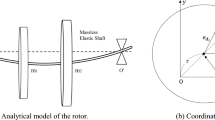Abstract
Assessment of high speed balance quality of a rotor with residual modal unbalance (RMU) has many advantages over traditional residual vibration method. In addition to be practically independent from support stiffness variations, it allows utilization of full train rotordynamic analysis for setting balance limits for a single rotor. Rotordynamic calculations of a turbine-generator train identify eigenmodes that can roughly be separated into two categories: single rotor and system modes. Large units with many rotors may have over 40 modes. The challenge is to select eigenmodes relevant for each rotor in the train and generate appropriate RMU requirements for high speed balancing. The other challenge is correlating eigenmodes of a single uncoupled rotor in a balancing facility to eigenmodes of a turbine-generator train and vice versa. The paper demonstrates that unbalance response calculations for turbine-generator train using appropriate modal weight sets exciting particular modes can allow for identification of modes relevant for high speed balancing facility conditions [1]. These modes can then be targeted for setting appropriate RMU limits. The emphasis is given to operating speed range and modes above 2nd critical speed. The paper offers an example of setting RMU tolerance for high speed balance for a large generator rotor based on rotordynamic analysis of turbine-generator train. Field vibration data is presented to demonstrate the applicability of the approach.
Access this chapter
Tax calculation will be finalised at checkout
Purchases are for personal use only
Similar content being viewed by others
References
L’vov MM, Uriev EV (2012) Use of modal weight sets for residual modal unbalance assessment of high speed balance quality of flexible rotors. In: IMechE 10th international conference on vibration in rotating machinery, proceedings
Wiese D (1996) Evaluation of the state of unbalance in flexible rotors—vibration velocity versus modal unbalance. In: IMechE 6th international conference on vibration in rotating machinery, proceedings
ISO 11342 (1998) Mechanical vibration—methods and criteria for the mechanical balancing of flexible rotors. International Organization for Standardization, Geneva
Jackson C (1979) The practical vibration primer. Gulf Pub. Co., Houston, p 32
ISO 1940-1 (2003) Mechanical vibration—balance quality requirements for rigid rotors in a constant (rigid) state—part 1: specification and verification of balance tolerances. International Organization for Standardization, Geneva
L’vov MM, Uriev EV (2010) Residual modal unbalance calculation errors due to influence coefficient deviations and balance plane selection, IFToMM 8th international conference on rotor dynamics, proceedings, pp 930–935
Author information
Authors and Affiliations
Corresponding author
Editor information
Editors and Affiliations
Rights and permissions
Copyright information
© 2015 Springer International Publishing Switzerland
About this paper
Cite this paper
L’vov, M. (2015). Application of Turbine Generator Train Rotordynamic Analysis for Setting Residual Modal Unbalance Requirements for High Speed Balancing of a Single Rotor. In: Pennacchi, P. (eds) Proceedings of the 9th IFToMM International Conference on Rotor Dynamics. Mechanisms and Machine Science, vol 21. Springer, Cham. https://doi.org/10.1007/978-3-319-06590-8_3
Download citation
DOI: https://doi.org/10.1007/978-3-319-06590-8_3
Published:
Publisher Name: Springer, Cham
Print ISBN: 978-3-319-06589-2
Online ISBN: 978-3-319-06590-8
eBook Packages: EngineeringEngineering (R0)



